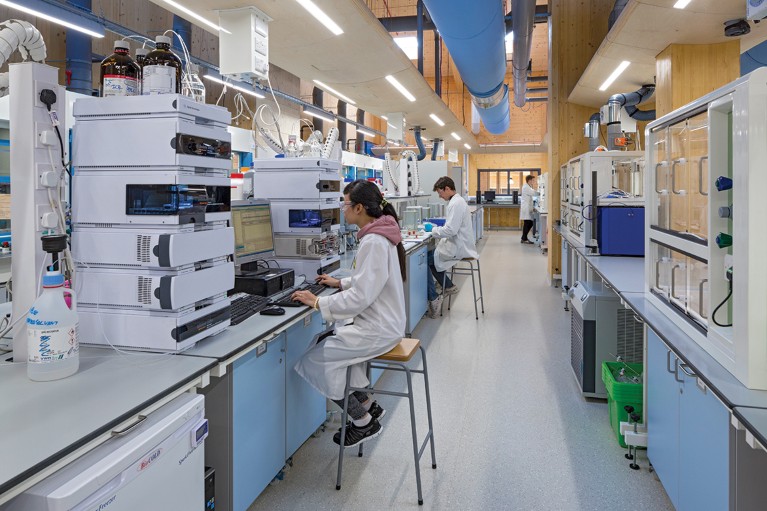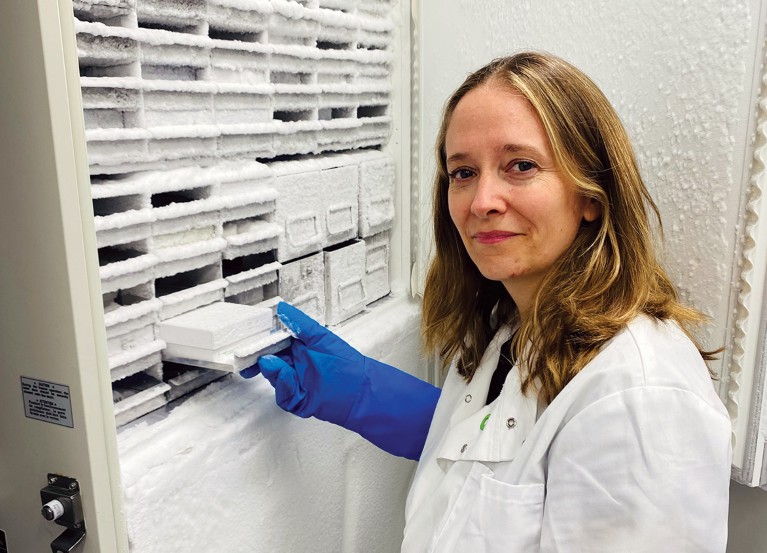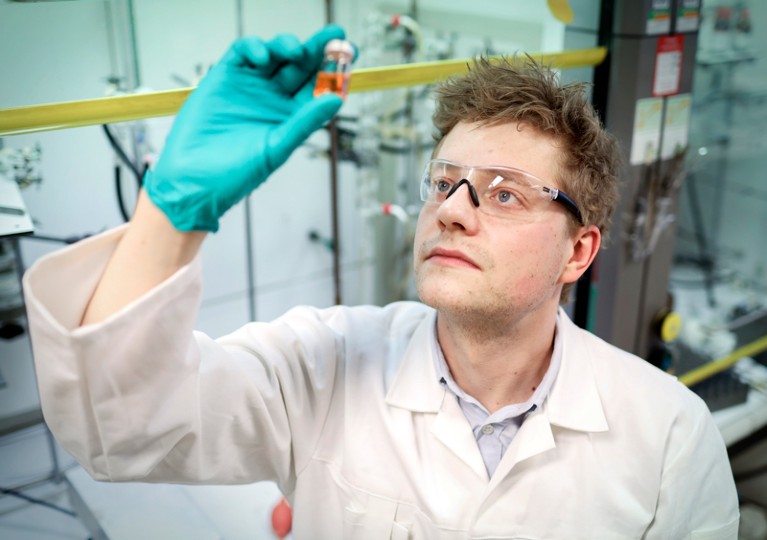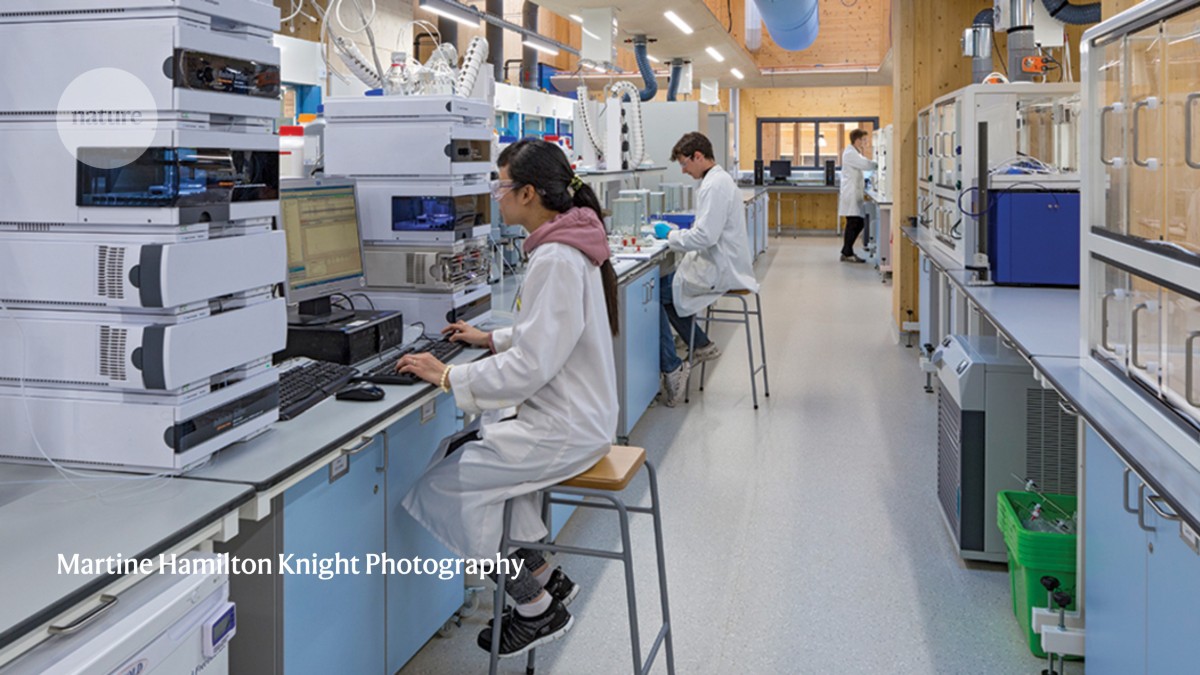
The Carbon Neutral Laboratory at the University of Nottingham, UK, consumes less than 40% of the power used by a typical lab of similar size.Credit: Martine Hamilton Knight Photography
As chief executive of My Green Lab, a non-profit organization in San Diego, California, James Connelly pays close attention to the marketing claims on scientific equipment and products: “Ultra efficient.” “Low impact.” “Renewable.”
Such words might offer comfort to scientists who are concerned about sustainability, but not every product lives up to the billing. “For some reason, it’s been seen as acceptable in the science industry for a company to go out and put a green leaf on their product without having any real meaning, verification or validation,” Connelly says.
Nature Spotlight: Green laboratories
Researchers are increasingly showing interest in sustainability, says Joanne Durgan, a cell biologist at the Babraham Institute in Cambridge, UK. After all, they are uniquely qualified to understand the various threats to the planet. “As a scientist, I’m used to collecting and analysing data, and that helped me see the scale and the urgency of the problem,” she says. “But it’s a bit out of our field to understand the best choices to make.” If scientists really want to reduce their environmental impact, she says, they’ll need to take an approach that’s as evidence-based and results-oriented as their research.
A 2024 report in the journal RSC Sustainability laid out some eye-opening statistics: at a typical university, research laboratories account for at least 60% of the energy and water use1. And, depending on their field of study, researchers have a work-related carbon footprint that is 7–25 times greater than the per-person climate-maintenance guideline set out in the Paris agreement.
“Most of the scientists that I work with are pretty well informed on environmental issues and are broadly keen to do the right thing,” says Durgan. “It’s maybe just hard to understand the best way to manage that impact.”
Embracing sustainable solutions
In some sectors, this awareness is turning into action, says Thomas Freese, the lead author of the RSC Sustainability report1 and a PhD student in green chemistry at the University of Groningen in the Netherlands. Leading research universities are cutting their environmental impact, funders are raising their standards and individual scientists are changing their protocols to make their research more efficient, less wasteful and more sustainable. “It’s an intellectual grassroots movement,” Freese says.
Durgan is one of a growing number of researchers who are trying to deliver the message that science can be more sustainable without compromising the scope or quality of the results. At the Babraham Institute, she chairs the steering committee for the Green Labs Initiative, a cross-disciplinary effort to reduce the planetary impact of research across the campus. As part of that, the institute retrofitted its heavily used autoclaves with a system that uses recirculated water, saving about 32,000 litres of water each week2.
To spread the word, Durgan and her co-authors laid out a plan of action for scientists who want to limit their environmental impact2. Much of the advice is geared towards lab-based researchers, but the team emphasizes that sustainability can be an issue in just about any field of science, including those in which most of the work happens on a computer. Astronomers, for example, have some of the largest annual carbon footprints in all of the sciences — up to 37 tonnes of carbon dioxide equivalent emissions per researcher1 — mostly because of the energy needed to run the supercomputers they rely on for research.
Some steps can be as simple as pushing a few buttons. Durgan explains that the Babraham’s labs turned the temperature of their 40 ultra-cold freezers up, from −80 °C to −70 °C . Some researchers warned that, if the freezers ever malfunctioned, the samples would spoil faster without that extra 10 °C cushion. To ease those concerns, Durgan spoke to Martin Howes, then the sustainable-labs coordinator at the University of Cambridge, UK, who reported that scientists there had made the adjustment without any issues. She was also reassured by the roster of researchers who reported their own experiences with −70 °C freezers to My Green Lab (see go.nature.com/3xtbeen). At the Babraham, the move reduced energy consumption by nearly 20% without affecting the frozen samples.

Cell biologist Joanne Durgan led an initiative to turn up the temperature of ultra-cold freezers to save energy at the Babraham Institute in Cambridge, UK.Credit: Joanne Durgan/ Babraham Institute
Fume hoods are also prime targets in energy-conservation efforts. As outlined in the RSC Sustainability report, a typical fume hood uses 3.5 times more energy than an average household does each year1. Harvard University in Cambridge, Massachusetts, has estimated that it costs more than US$4,500 to run a fume hood per year, a significant dent to a lab’s budget. Simply closing the sliding window at the front of the hood when not working on an experiment can cut the airflow rate by two-thirds, with similar reductions in energy expenditure1. A Harvard initiative in 2015–16 to close fume hoods reduced energy costs by nearly $200,000 each year3.
Durgan warns that other steps aren’t always so obvious or clear-cut. “You might think about trading some plastic items for reusable glassware,” she says. “But that’s going to use water, and it’s going to require energy to sterilize the glass.”
Durgan adds that any cutbacks in the name of sustainability could lead to more waste if the research results aren’t reliable. “The more effort we make to be sure that our data is robust and reproducible, the less collective time and resources are going to be wasted by the international research community trying to chase or follow up those findings,” she says.
Unfortunately, Connelly says, scientists can’t simply consult manufacturers’ labels to determine which products deliver efficiency without compromising research results. In a practice known as greenwashing, firms can attach claims of sustainability to truly wasteful products. “Companies are using their own standards,” Connelly said. “Without third-party verification, you have to be smart enough to know which standards are credible and which ones aren’t.”
Backing the movement
In a bid to improve clarity, My Green Lab has created ACT (accountability, consistency, transparency), a database of independently generated environmental-impact scores for more than 1,200 lab supplies, from pipettes and solvents to freezers and mass spectrometers. The scores, presented on a branded ACT label, take into account the full life cycle of a product, including its manufacturing impact, use of energy and water, packaging and ultimate disposal.
My Green Lab also offers a road map to scientific sustainability through a certification programme that requires labs to meet certain standards and benchmarks on the use of energy, water and supplies. Those that want to go through the process have to submit an application and pay a fee, currently $500 for academic labs and $4,000 for commercial labs. So far, around 1,200 labs in 47 countries have been certified. Not all will qualify for certification, but successful applicants are awarded a wall plaque. Certification lasts for two years; if a lab wants to remain certified after that, it has to go through the process again.
“These types of programme have value beyond the cost of the certification,” says Davida Smyth, a microbiologist at Texas A&M University in San Antonio who co-authored a 2020 paper on the challenges of making research labs more sustainable4. Certification “sends a signal to your colleagues, other labs, your students, the institution and beyond. This must be a communal effort”.
Plaques, stickers and other forms of recognition can be meaningful, but science might need a stronger incentive structure to attract more labs to the movement, Durgan says. She applauds the Concordat for the Environmental Sustainability of Research and Innovation Practice, released in April by Wellcome in London, the largest UK charity in terms of expenditure and a major funder of biomedical science worldwide (see go.nature.com/4d4dpqs). By the end of 2025, Wellcome will only fund labs that have received some level of accreditation, such as from My Green Labs or LEAF (Laboratory Efficiency Assessment Framework), a programme at University College London (see go.nature.com/4etcnwe). Likewise, Cancer Research UK — which has set a goal to reduce its direct and indirect carbon emissions by 50% by 2030 — will require that all funding applicants be LEAF-certified by 2026.
Funding agencies are really the only entities that can bring large-scale change, Durgan says. “People who might not have been so motivated from an environmental perspective will now have a strategic reason to be more sustainable, because funding is going to depend on it.”

PhD student Thomas Freese at the University of Groningen says his institution has saved more than $440,000 each year by adopting energy-efficiency measures.Credit: Henk Veenstra/ARC CBBC
Connelly applauds Wellcome’s move to require certification, but he thinks that other agencies, such as the US National Institutes of Health (NIH), need to follow suit in the drive for sustainable science. In the United States, the NIH is “the elephant in the room”, he says, noting the agency’s massive influence on biomedical research in the country. “We need leadership from that institution to drive change through the broader academic industry.”
In a statement to Nature, the NIH Office of Extramural Research said it doesn’t require lab certification, but does “consider the scientific environment during peer review and monitor compliance with all requirements post-award through our grants oversight procedures”.
Cost savings can also serve as an incentive. Freese says that at the University of Groningen, the 46 labs that received LEAF certification saw total cost savings of more than $440,000 each year — an average of more than $9,500 per lab — by adopting energy-saving measures that required minimal investment.
Individual labs have reported even more impressive results. In 2022, Jane Kilcoyne, a research chemist at the Marine Institute in Galway, Ireland, achieved annual savings of $16,000 by, among other things, turning up the temperature of freezers, closing fume hoods when possible, and ordering and preparing solutions and reagents only as needed (see Nature https://doi.org/nhhm; 2022).
Future visions
Despite some setbacks, sustainability is also leading to savings for the Carbon Neutral Laboratory, a one-of-a-kind facility at the University of Nottingham, UK. The lab officially opened in 2017 at a reported cost of $20.8 million, with most of the funding coming from the multinational pharmaceutical company GSK. The building, powered partly by solar arrays and a biofuel heat system, is designed to consume less than 40% of the power used by a typical lab of a similar size. “We’re paying back the carbon [used for construction] by not buying electricity from the grid,” says chemist Peter Licence, director of the lab. “The whole concept is an experiment.”
Still, it will take some time for the lab to live up to its name. The original aspiration was to reach net carbon neutrality within 25 years, enough time to allow energy savings to offset the energy required for its construction. “We are, at the moment, slightly behind target because there’s been some technical problems with some of the mechanical, electrical and combined heat and power units that are run on biomass,” Licence says. “I’m fairly confident that we will achieve carbon neutrality by the 25-year time frame. But where we sit right now, I would say that we’re probably three, four or five years behind that payback schedule.”
He says the Carbon Neutral Laboratory has found efficiencies through collaboration. “We share a lot of things like fume hoods and spectrometers,” says Licence. Sharing takes more planning and patience, but helps to save energy and space while promoting conversation and collaboration. “The entire building is designed to make people think differently. Students and academics share ideas, work together and often translate knowledge in a much more rapid and much less siloed way than we would have in a traditional old-school chemistry department.”
Scientists at the Carbon Neutral Laboratory are encouraged to reduce their use of highly toxic solvents, including chemicals that have been part of standard protocols for decades. “If a reaction that I want to do requires me to use dichloromethane, I will then challenge myself to look for an alternative,” Licence says.
But researchers are never asked to scale back their ambitions or to limit their reach in the name of sustainability, he says. “The science speaks for itself,” he says. “It just so happens that we executed that science in the world’s most sustainable chemistry laboratory.”
Before scientists make any changes to their protocols, they should be confident that their results won’t be affected. “If your research requires you to use 20 litres of solvent or 20 pipette tips, you should absolutely do that,” Freese says. “You should not feel bad about conducting more experiments if it means your results become more significant and reproducible.”
Many scientists could reduce their environmental impact by rethinking their approach to planning and executing experiments, Durgan says. With more careful planning and forethought, they could cut down on redundant tests or experiments, a move that would save money and time as well as energy and resources. “Being as critical as you can be about what experiment you choose to do and how you choose to do it at the front end is just a good way to do your science anyway.”



